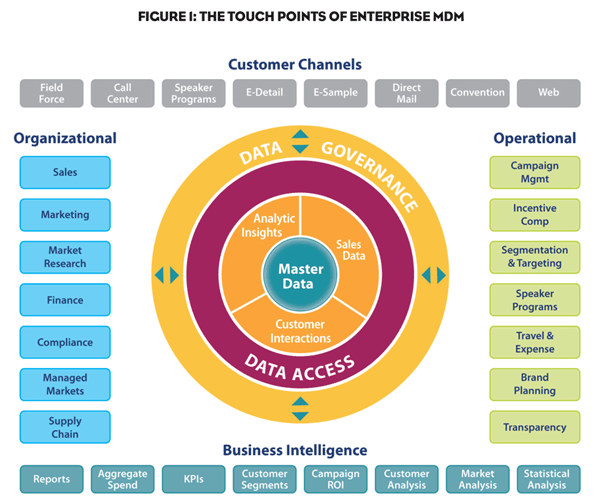Today’s life sciences companies often find themselves in an unfortunate situation when it comes to their systems for managing master data—they’ve allowed spot solutions to proliferate, function by function, only to have integration issues later on. However, with proper forethought and careful planning, they can ensure that their Master Data Management (MDM) solutions solve their current requirements and build toward future needs. Tools created for a single-use case can be integrated later on if they offer an upgrade path to more advanced features and broader applications.
Functional versus Enterprise Solutions
Both functional (single-use) MDM solutions and those created for the enterprise have their pros and cons; and there is no automatic right or wrong answer as to what is best.
Functional MDM solutions are:
- Practical, fit-for-purpose solutions that are limited in scope and address more focused needs of a particular business function.
- Implementable in a fairly short time frame, requiring only a limited amount of configuration and processing power and providing quick “time to insight” for the functional team.
- Less expensive to create because they address only the needs of a discrete group of stakeholders.
Small and emerging companies may turn to separate functional MDM systems before they are ready or able to move to an enterprise system. For large companies with installed enterprise systems, a functional system may be an easy and quick way to meet the needs of an individual group such as a new business unit or sales force.
Yet, functional solutions can pose problems that are expensive and time consuming to fix: 1) The inability to adapt to broader uses as requirements grow; 2) the spawning of multiple, conflicting records for the same entity and the corresponding loss of “master” data; and 3) the need to share or receive information from other functional systems resulting in a high-maintenance web of complexity.
Enterprise MDM Solutions
In contrast, enterprise MDM solutions serve multiple company functions simultaneously, even across geographies (Figure 1). These solutions are:
- Powerful, complex and comprehensive systems capable of managing massive amounts of information, yet difficult and more time-consuming to design, implement and modify.
- Designed to serve multiple stakeholder groups, satisfying requirements from a range of downstream users.
- Highly configurable for a wide array of capabilities.
While implementing enterprise-wide systems can take months or even years to complete, companies can realize savings through consolidated support in the integration and maintenance of a singular system.
Making the Choice
The fundamental point is that functional solutions are sufficient only when limited scope is required. And, even then, they must offer an upgrade path to more advanced features and broader application—at a price point and implementation time frame that remains in line with the original intent of the functional solution. If upgrading a functional solution makes it costly and unwieldy, it would be better to choose an enterprise solution at the outset.
In choosing between a scalable functional solution and an enterprise solution, companies should consider:
- What types of data are involved, and who needs access?
- Does the company’s strategy require a 360-degree view of the customer—enabling different users to look at each customer differently?
- Are efficiencies to be gained by adopting one system?
- How much rigor is required to support data quality, with planned spikes in workload?
- Are acquisitions, mergers or co-promotions part of the business strategy?
Recommended Practices
Companies that follow certain guiding principles can avoid the perils of going down the wrong path while implementing any combination of functional and enterprise-wide systems. They take a long-term view and plan for data and technological needs that will become more complex and intertwined over time. In doing so, they rely on a single, base source of industry data and keep MDM processes and technology separate from the applications that will use master data.
A company selecting a solutions provider should consider the organization’s ability to scale, familiarity with the master data and applications, industry knowledge and compliance status with ISO 9001.
Other recommended practices include: Adopting a common underlying technology across MDM systems; establishing data governance policies and processes to maintain data integrity; employing a federated or distributed data stewardship model to ensure the quality of master data; and providing reports to stakeholders on the quality, timeliness and accuracy of the master data.
When upgrading to an enterprise system, as a rule of thumb, 25% to 60% of the data records from different functional systems will require manual verification during the conversion. A future-ready solution involves multiple steps, beginning with governance (a careful study of the people, processes, scoping and definitions to ensure quality). Adopting the new technology then requires a vigorous and phased approach to matching and harmonizing the data.
Building functional solutions with a broader end goal in mind can be a planned process that avoids a complete overhaul of systems and procedures. All life sciences companies should assume that they will eventually want and need a common MDM solution across their commercial organization.





